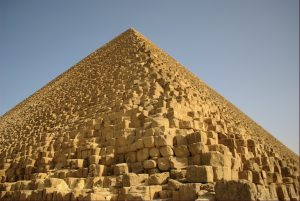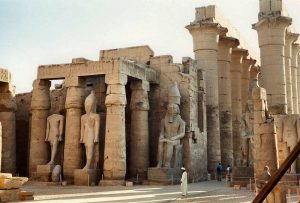Ancient Egypt stands as a testament to human ingenuity, with its architectural marvels serving as enduring symbols of power, innovation, and cultural richness. From the towering pyramids to the enigmatic sphinx, each structure tells a story of a civilization that thrived along the banks of the Nile. In this article, we embark on a journey travel guide through time to unravel the mysteries of the Echoes of Pharaohs: Architectural Wonders of Ancient Egypt.
Architectural Wonders of Ancient Egypt
The Great Pyramids of Giza stand as the most iconic symbols of ancient Egypt, built as tombs for the pharaohs Khufu, Khafre, and Menkaure. These colossal structures, constructed over 4,500 years ago, continue to awe and inspire visitors from around the globe. Standing as tall as 455 feet, the Great Pyramid of Khufu is the largest of the three, boasting remarkable precision in its construction despite the limited technological resources of the time.

The Sphinx: Guardian of the Pyramids
Adjacent to the Great Pyramids lies the enigmatic Sphinx, a mythical creature with the body of a lion and the head of a human. Carved from a single limestone block, the Sphinx is believed to represent the pharaoh Khafre, whose pyramid it guards. Standing at 66 feet tall and 240 feet long, this majestic statue continues to captivate visitors with its imposing presence and mysterious smile.
The Temple of Karnak
The Temple of Karnak, located in the ancient city of Thebes (modern-day Luxor), is one of the largest religious complexes ever built. Dedicated to the worship of the god Amun, Karnak served as the focal point of religious activity for over 2,000 years. Its sprawling complex includes the Great Hypostyle Hall, adorned with towering columns intricately carved with hieroglyphics and depictions of gods and pharaohs.
Abu Simbel Temples
Constructed during the reign of Ramses II, the Abu Simbel Temples are a testament to ancient Egyptian engineering and artistic prowess. Carved into the mountainside along the banks of Lake Nasser, these temples were dedicated to the gods Ra-Horakhty, Ptah, and Amun, as well as to Ramses himself. The most remarkable feature of Abu Simbel is the alignment of the temples, designed to capture the sunlight and illuminate the inner sanctuaries on specific days of the year.
Valley of the Kings
The Valley of the Kings, located on the west bank of the Nile near Luxor, served as the burial site for pharaohs and powerful nobles during the New Kingdom period. Carved into the rock face, the tombs of the Valley of the Kings are adorned with elaborate paintings and hieroglyphics depicting scenes from the afterlife. The most famous tomb in the valley is that of Tutankhamun, whose burial chamber contained treasures that have captivated the world for centuries.
Luxor Temple
Built over the course of several centuries, Luxor Temple is a testament to the grandeur of ancient Egyptian architecture and religious devotion. Dedicated to the god Amun-Ra, this temple complex served as the focal point for the annual Opet Festival, during which the statues of Amun, Mut, and Khonsu were paraded through the streets of Thebes. Today, Luxor Temple stands as a testament to the enduring legacy of ancient Egypt’s spiritual and cultural heritage.
Memphis: The First Capital of Egypt
Founded over 5,000 years ago, Memphis was the capital of ancient Egypt during the Old Kingdom period. While little remains of the city today, its legacy lives on in the nearby necropolis of Saqqara, home to the Step Pyramid of Djoser, the first pyramid ever built. Constructed by the legendary architect Imhotep, the Step Pyramid is a revolutionary feat of engineering and a precursor to the iconic pyramids of Giza.
Aswan High Dam
While not an ancient wonder itself, the Aswan High Dam has played a crucial role in preserving Egypt’s archaeological treasures. Completed in 1970, the dam regulates the flow of the Nile River, preventing floods and ensuring a stable water supply for irrigation and electricity generation. However, the construction of the dam necessitated the relocation of several ancient temples, including the Temples of Abu Simbel, which were painstakingly dismantled and reconstructed to save them from flooding.
The Mortuary Temple of Hatshepsut
The Mortuary Temple of Hatshepsut, located on the west bank of the Nile near Luxor, is a masterpiece of ancient Egyptian architecture. Built by Queen Hatshepsut, one of ancient Egypt’s few female pharaohs, the temple is renowned for its elegant design and dramatic cliffside location. Dedicated to the god Amun and the queen herself, the temple features terraced colonnades, statues of the queen as a male pharaoh, and vividly colored reliefs depicting scenes from her reign

Philae Temple Complex
Situated on the island of Philae in the Nile River, the Philae Temple Complex is dedicated to the goddess Isis, the divine mother and patroness of magic. Built over several centuries, the complex includes temples, shrines, and other religious structures adorned with intricate carvings and hieroglyphics. Despite being partially submerged by the waters of Lake Nasser following the construction of the Aswan High Dam, the temples were relocated and restored in a remarkable international rescue effort.
The Colossi of Memnon
Standing guard at the entrance to the Mortuary Temple of Amenhotep III, the Colossi of Memnon are two massive statues representing the pharaoh seated on his throne.
Carved from single blocks of quartzite sandstone, these colossal figures once stood over 60 feet tall and weighed hundreds of tons each.
Though damaged by earthquakes and the ravages of time, the Colossi of Memnon remain a testament to the grandeur of ancient Egyptian art and architecture.
Dahshur Pyramids
Located south of Cairo, the Dahshur Pyramids are among the earliest examples of pyramid construction in ancient Egypt. Built during the reign of the pharaoh Snefru, these pyramids represent a transitional phase between the step pyramid of Saqqara and the true pyramids of Giza. The Bent Pyramid and the Red Pyramid, named for the color of the limestone used in their construction, showcase the evolution of architectural techniques that would culminate in the iconic structures of the Giza plateau.
Conclusion:
Egypt, as showcased by the Echoes of Pharaohs, continue to inspire awe and fascination in people from around the world. From the towering pyramids of Giza to the magnificent temples of Karnak and Abu Simbel, these structures stand as enduring testaments to the ingenuity, craftsmanship, and spiritual beliefs of one of the world’s greatest civilizations. Through the meticulous planning and construction of these monumental edifices, ancient Egyptians sought to immortalize their pharaohs and honor their gods.










